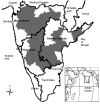Chikungunya outbreaks caused by African genotype, India
- PMID: 17176577
- PMCID: PMC3290956
- DOI: 10.3201/eid1210.060529
Chikungunya outbreaks caused by African genotype, India
Abstract
Chikungunya fever is reported in India after 32 years. Immunoglobulin M antibodies and virus isolation confirmed the cause. Phylogenic analysis based on partial sequences of NS4 and E1 genes showed that all earlier isolates (1963-1973) were Asian genotype, whereas the current and Yawat (2000) isolates were African genotype.
Figures


References
-
- Jupp PG, McIntosh BM. Chikungunya virus disease. In: Monath TP, editor. The arboviruses: epidemiology and ecology. Vol. II. Boca Raton (FL): CRC Press; 1988. p. 137–57.
MeSH terms
LinkOut - more resources
Full Text Sources
Other Literature Sources
Medical
Molecular Biology Databases
